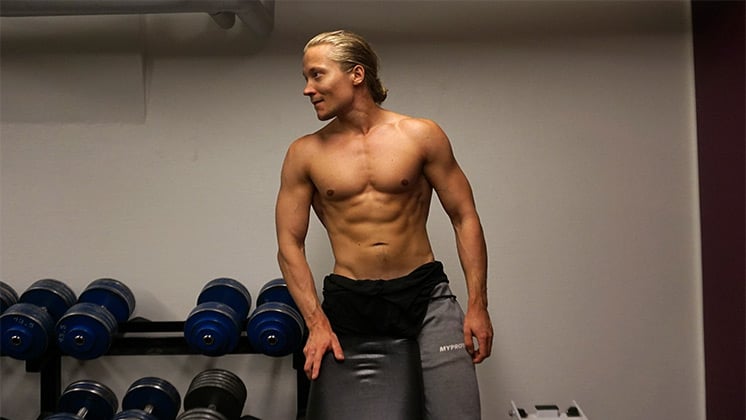
This is the most comprehensive dieting guide for getting ripped that you’ll find anywhere.
Table of Contents
Why I Wrote This Guide
Getting ripped is at the forefront of most fitness interested people’s minds.
Heck, it goes even further than so, everyone wants to look and feel great, it’s a basic human need.
And that’s why I wrote this guide – to empower you with the knowledge to achieve the body that you’ve always wanted, whether it’s for competing or looking better in general.
There are plenty of dieting guides on how to get ripped out there, from textbooks to online video tutorials, you can really choose whichever you like.
But, I felt that something was missing – a free guide that really goes in-depth and breaks the information down into actionable pieces and in the correct order of importance.
How To Diet To Get Ripped: The Complete Guide closes that gap.
Who This Guide Is For
I wrote this dieting guide for physique/bodybuilding competitors, fitness enthusiasts and every day gym goers looking to step up their game and achieve a better body composition – meaning more muscle and less fat, or simply put; to get ripped!
In this guide, you’ll learn everything from counting calories and macros, to nutrient timing and which supplements can be useful, whether your goal is cutting, bulking or maintaining weight.
You’ll also learn how to stay healthy while also being able to enjoy yourself as much as possible while working towards your ultimate physique goals.
The guide will be set up in the order of most important to least important when it comes to building a ripped physique.
Why the Pyramid?
Through the guide I’ll use the famous nutrition pyramid created by Eric Helms to better illustrate how to set up a successful diet.
The pyramid is exclusively based on science and is, therefore, a highly reliable source. And it displays through hierarchy what’s most important when it comes to getting a ripped body.
Where calories at the bottom are the most important factor and supplements at the top are the least important.
The pyramid looks like this:
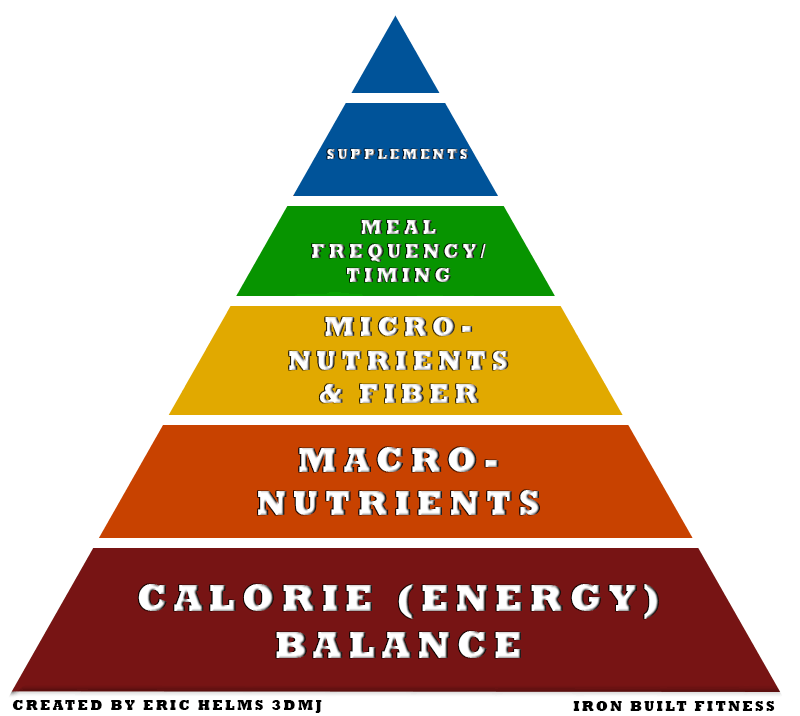
Pyramid created by Eric Helms, author of the amazing muscle and strength pyramids books.
As you can see, the order of importance to successfully lose fat, build muscle or maintain a certain body composition is as the pyramid shows.
Here’s a quick example:
Let’s say your goal is fat loss.
If the first thing you do is look at meal frequency or supplements (at the top of the pyramid) to achieve this goal, chances are high you won’t be successful.
Why?
Because you miss out on the larger, more important factors for fat loss.
On the other hand, if you focus on calories and macronutrients first, you would successfully account for 80 % of the factors resulting in fat loss.
So, are the upper factors important at all?
Yes, but only if the foundation is in place.
Now that you understand how the pyramid is built up, here are all the parts of the guide:
Part 1: How to Set Up Your Caloric Intake
A kilocalorie (kcal) is a unit of energy defined as the approximate amount of energy required to raise the temperature of one kilogram of water.
Since it’s energy, kilocalories falls under the law of thermodynamics.
Which essentially means that:
In order to lose, gain or maintain weight, you must also take in less, more or equal the amount of calories that your body uses per day.
So, no matter what or when you eat, if calorie balance isn’t manipulated to reach your desired outcome, the outcome won’t be reached.
And in this part you’ll learn how to set up your caloric intake to improve your body composition. Whether that’s bulking to build muscle or cutting to lose fat.
Let’s go!
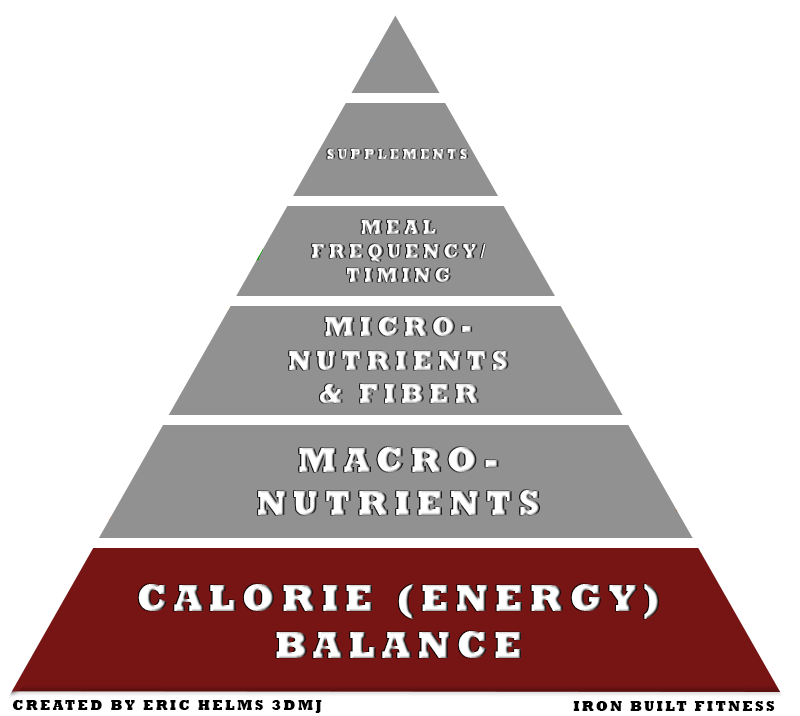
Pyramid inspired by Eric Helms, author of the muscle and strength pyramids books.
Here’s what you’ll learn in this part:
- How to set up an optimal caloric deficit for fat loss.
- How to set up an optimal caloric surplus to gain muscle.
- How to count & track your calories depending on the goal.
- How you adjust your caloric intake if things doesn’t go as planned.
How to Set Up Your Caloric Intake for Cutting or Bulking
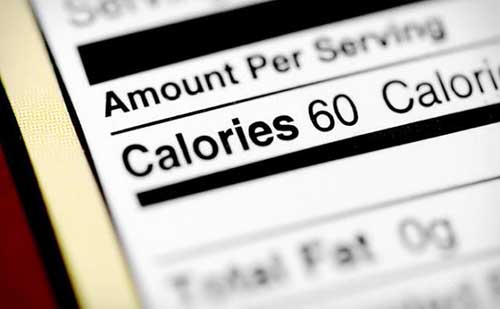
Manipulating your caloric intake is done for one of these goals:
- Lose weight, preferably in the form of fat.
- Gain weight, preferably in the form of muscle.
Doing both simultaneously is possible, but it’s highly related to body fat percentage and training experience.
An overweight beginner can burn fat and build muscle at the same time.
But, as soon as the body fat percentage gets lower and the first few months of new training stimulus has passed, achieving both goals simultaneously becomes tough.
So, if you’re passed the first few months of training and lie within a reasonable range of body fat (8-18 % for men and 15-30 % for women).
Then you should focus on either cutting to lose fat or bulking to gain muscle.
As this will be the quickest way to improve body composition.
Important to know when it comes to setting up caloric intake.
- You can lose fat faster than you can build muscle. Packing on muscle requires construction of new muscle tissue, tendons and ligaments etc. Fat loss, on the other hand, is just stored energy that the body can easily take from.
- Excessive consumption of food during a bulk will lead to muscle growth, but also a lot of unnecessary fat storage. Bulking should be controlled, and for that reason, I’ll call it lean-bulk instead of bulk from now on.
- Phases of caloric deficits can and shall be larger than phases of surpluses.
- The diet should determine the deficit or surplus, not the training. Firstly, it’s easier to control the energy balance through diet than through training. Secondly, training should be used to reach a certain goal, not to manipulate energy balance. Thirdly, extra training can mess with recovery for the primary training. With that said though, cardio can help with energy expenditure, but it should never be the primary method for it.
Calculate Your Caloric Need
1. Calculate BMR
BMR (Basal Metabolic Rate) is how much energy you need to maintain your body weight during a day of complete rest, the energy you would need if you were in a coma.
BMR is the first thing you must calculate to figure out your caloric expenditure.
The easiest way to count your BMR is with a mathematic formula that gets very close to more advanced formulas, and it’s this one:
Bodyweight (in lbs.) x 12 kcal = Basal Metabolic Rate (BMR)
Bodyweight (in kg) x 26 kcal = Basal Metabolic Rate (BMR)
2. Calculate Daily Activity
Hopefully, you’re not in a coma and are reading this, that would be scary!
You’re probably not lying still all day either, right?
For that reason, you must multiply your BMR with your daily activity. Here’s how:
Slim to no daily activity: x1.2
Low daily activity (training 1-3 days per week): x1.375
Medium daily activity (training 3-5 days per week): x1.55
High daily activity ((training 6-7 days per week)): x1.725
Very high daily activity (2 daily training sessions): x1.9
The final numbers you get from multiplying your BMR with your daily activity are called:
TDEE (Total Daily Energy Expenditure) and are an estimation at best, and will need to be adjusted overtime.
The biggest reason TDEE are only an estimation is because of NEAT (Non-Exercise Activity Thermogenesis).
Some people move and burn more calories than others do throughout a day subconsciously.
Studies show that NEAT can result in one individual burning up to 1000 calories more than another individual throughout a day.
TDEE Examples:
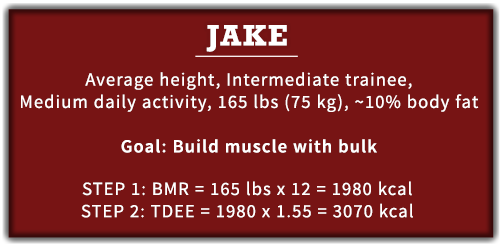
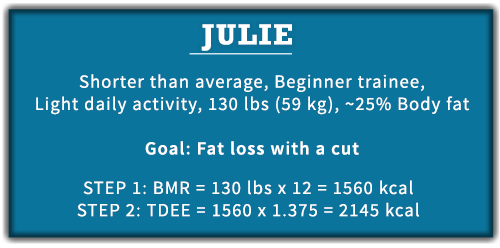
3. Set up a Theoretical Caloric Deficit or Surplus, Depending on Your Goal
If your goal is to cut and lose fat, set your caloric deficit after current body fat percentage.
If your goal is too build muscle, set your caloric surplus after training experience (beginner, intermediate or experienced).
4. Adjust the Caloric Intake Up or Down
Adjust your caloric intake depending on the trend of your scale weight and measurements (covered in part 1) on a weekly basis.
Cutting: How to Set Up Your Caloric Deficit
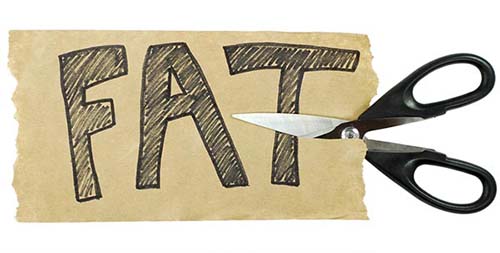
Size of the Caloric Deficit
How large of a caloric deficit you choose, obviously affects how quickly you’ll lose weight, but only up to a certain point before unpleasantries will arise.
This point is largely associated with your current body fat percentage.
The more fat you carry, the larger the deficit can be, without risk of muscle loss, extreme hunger, low energy and other unpleasantries following a “crash diet.”
To avoid these unpleasantries, I recommend using the following numbers when deciding your caloric deficit, which are based on body fat percentage instead of bodyweight:
| Body Fat % | Fat Loss/Week |
| 30%>
20-30% 15-20% 12-15% 9-12% 7-9% <7% |
~1.1 kg (2.4 lbs)
~0.9 kg (2 lbs) 0.45-0.7 kg (1-1.5 lbs) 0.45-0.6 kg (1-1.3 lbs) 0.35-0.45 kg (0.75-1 lbs) 0.2-0.35 kg (0.45-0.75 lbs) ~0.2 kg (0.45 lbs) |
You can find out your body fat percentage here: Body Fat Percentage Calculator
How to Setup the Caloric Deficit Using Your Previous Calculations
Watch this video, which walks you through how to set up an optimal caloric deficit for fat loss:
[fusion_youtube id=”https://www.youtube.com/watch?v=d8Nh1B7rQs8″ alignment=”center” width=”822″ height=”400″ autoplay=”false” api_params=”” hide_on_mobile=”small-visibility,medium-visibility,large-visibility” class=””][/fusion_youtube]
To lose 2 lbs. (1 kg) of body fat, a caloric deficit of 7000 calories is required.
As you can see in the table above, a caloric deficit of 7000 per week would have been good for a person with 20-30 %+ body fat.
For leaner individuals between 10-25 %, I don’t recommend a quicker weight loss than 1-1.5 lbs. (0.5-0.7 kgs) per week.
Even if the caloric deficit can be larger without risking muscle loss, it’s a lot easier mentally sticking to a fat loss diet long-term with a moderate deficit.
To lose 1-1.7 lbs (0.5-0.7 kgs) a week, a deficit of 3500-4900 calories per week or 500-700 calories per day is required.
And this is how Julie who has the goal of cutting would set up her caloric deficit:
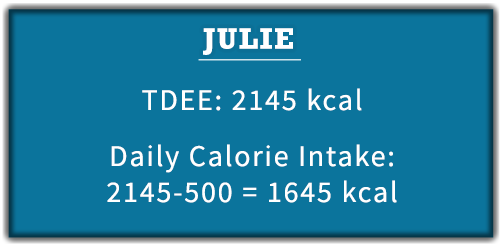
As you can see, Julie’s daily caloric intake will be 1645 calories to lose 1 lb a week.
Even though Julie has a body fat percentage of ~25 % and could use a larger deficit it’s still better for her long-term adherence to the diet, if she sticks to a deficit of “just” 500 calories per day.
Another reason why I don’t recommend a bigger caloric deficit than 500 per day in Julie’s case, is because 1645 calories already means a very small amount of food.
So small that if she’s going even lower, extreme hunger can quickly become an issue.
*This is where a moderate amount of cardio can be a good tool to increase the energy intake a bit if hunger is a problem. Just remember not to do too much cardio and surpass 1 lbs (0.5 kg) of weight loss per week.
Numbers Are Only Theoretical
The fact that 3500 calories are required to lose 1 lbs (0.5 kg) per week is just what will happen theoretically.
Factors such as NEAT (subconscious movements which I mentioned earlier) will affect these numbers.
In addition to that, you’ll also experience metabolic adaptations.
This means that your caloric requirements will sink as you lose weight, causing your mathematical calculations to become inaccurate.
That’s why tracking and measuring your progress is important.
By doing so, you can adjust your caloric intake up or down, depending on the scale and measurements, getting you on track again.
Finally, it’s not uncommon that your scale weight and measurements stalls for up to a couple of weeks.
This happens because of water retention.
During retention, fat loss does still take place, but as fat cells shrink they get filled with water.
This happens because of increased cortisol levels in the body, followed by stress.
Yes, a caloric deficit is a stress factor and so is training.
To avoid this, sleep well and work on bringing down other stress factors in your daily life.
If you encounter water retention anyways, all you can do is just wait it out.
One morning you can wake up and experience the famous “Whoosh effect.”
This is when the body suddenly loses all the retained water at once, and you end up surprised, a few pounds lighter than the day before.
Water retention is a natural thing that happens for both sexes, but is more common amongst women.
Bulking: How to Set Up Your Calorie Surplus
How Fast Can You Build Muscle?
How you should set up your caloric surplus to gain muscle is highly associated with training experience.
Compare that to fat loss, which is based on body fat percentage to decide how fast you can lose it, thus, have nothing to do with training experience.
By categorizing training age, you can get a pretty accurate estimation of how much muscle you can build in a month.
This is extremely useful when it comes to deciding your caloric intake and how much you can allow your body weight to increase.
Here’s a rough estimate of how much muscle you can build per month if you do everything correct with your training:
| Category | Maximum Rate of Muscle Growth |
|---|---|
| Beginner
Intermediate Advanced |
1-1.5% of lean body mass per month
0.5-1% of lean body mass per month 0.25-0.5% of lean body mass per month |
Alan Aragon’s model of average maximum rate of muscle gain.
- Taller people will use the higher number.
- Beginners that already are fairly muscular (maybe from a lifetime of sports or heavy manual labor) can probably expect the same muscle growth as an intermediate.
How Much Energy is Required to Build Muscle?
People that are a lot smarter than myself, have figured out that in theory it requires around 2500 calories to build 1 lb (0.5 kg) of muscle.
This means that the ideal caloric surplus for a beginner should be 5000 calories per month since they can build around 2 pounds of muscle per month.
However, in most cases, more calories than this is required to maximize muscle growth.
Why?
Because the hormonal environment in the body favors muscle growth more when the caloric intake is even higher.
The Three Ways to Bulk
I would say that there are three different ways to set up a bulk:
1. Dirty Bulk/Uncontrolled Bulk – With this bulking method you’re eating as much food as you can possibly handle, with the goal of adding muscle as quickly as possible.
2. Lean-Gains – With this bulking method, the goal is to slowly gain muscle without gaining fat.
3. Lean-Bulk/Controlled Bulk – With this bulking method you’ll maximize muscle growth while allowing for only moderate amounts of fat to be stored.
Which method you chose is totaly up to you.
If you’re chosing any of the bulking methods where you’ll gain fat, you’ll build muscle at the fastest rate possible, but you’ll have to cut body fat in between.
Also, and this is important, you should be fairly lean before you jump on a bulk, both for health reasons and for quicker muscle gain.
Between 8-12 % body fat for males and 18-24 % bofy fat for females is a great place to start at.
Okay, so let’s look at the different bulking methods, and how to set them up one by one:
1. Dirty Bulk/Uncontrolled Bulk
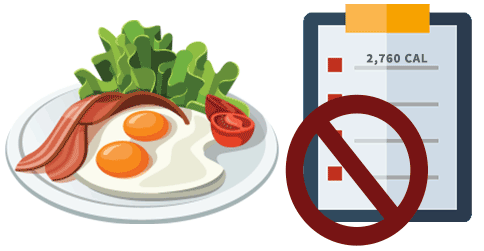
It’s not uncommon that some people eat 1000-2000 calories more per day than what’s needed to maintain their current body weight.
This amount of energy is a lot larger than what’s needed to maximize muscle growth.
So parts of the surplus of calories will be burned off through NEAT, and most of it will be stored as fat.
Here’s a demonstration of the unproportional ratios between fat and muscle gain when “dirty bulking”
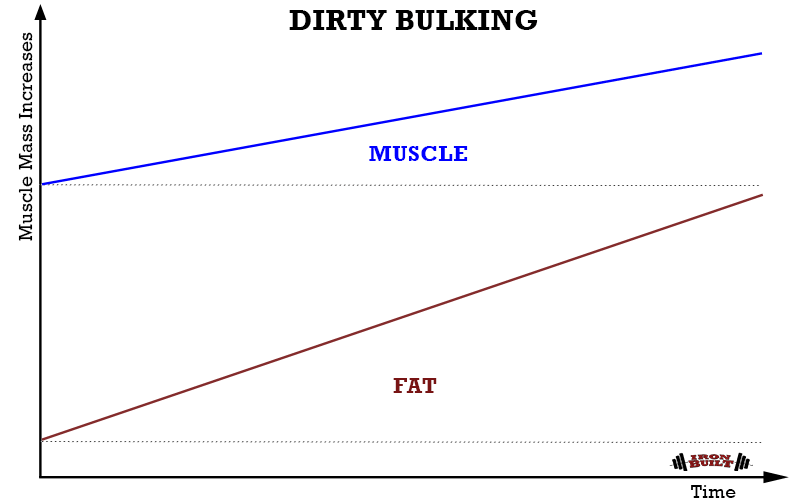
As you can see in the graph, you’re gaining fat a lot faster than muscle mass.
Very rarely do I recommend this bulking method, for reasons that’s rather obvious:
Adding a lot of body fat is unattractive, unhealthy and can actually make it harder to build muscle.
Not only that, if you’re getting too fat, you’ll need a very long cutting phase just to get back to a more reasonable body fat percentage again.
Which will slow down your rate of development in the long-term.
Should You Dirty Bulk?
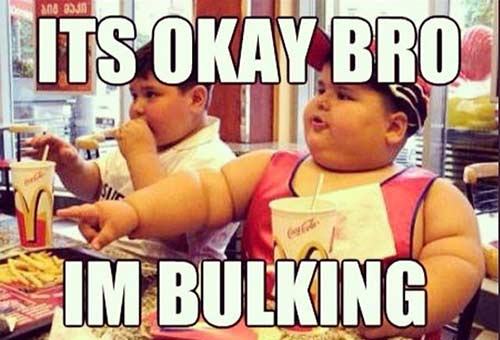
I recommend this approach ONLY if you’re extremely skinny and have problems gaining weight. If you have a low appetite and high NEAT, or a combination of both, then this method is probably the way to go.
How to implement a dirty bulk:
Eat, just eat!
Actually, there’s not much else you have to do. You don’t have to count your calories if you’re eating until you’re full and beyond.
What I would recommend though is that you train as hard, smart and proper as you possibly can in the gym.
While also implementing daily walks, light cardio and remaining active during the days.
This way you can achieve a tiny bit better nutrient partitioning.
Meaning, more of the energy goes towards building and storing glycogen in the muscles instead of going directly to fat cells.
2. Lean-Gains
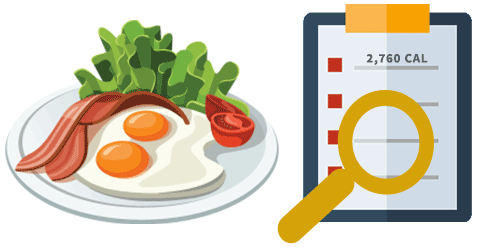
With this bulking method, the goal is to slowly gain muscle without gaining fat.
Sounds good, right?
And it is, this video explains why and how:
But, there are two big drawbacks with this method:
- It’s extremely hard to notice progress and changes because building new muscle tissue takes a long time. In fact, looking for gains in muscle mass is like watching paint dry. With the lean-gains method, the only guidelines you have is to depend on your progress in the gym, meaning that the volume and weights you’re training with increases over time.
- You can’t maximize your muscle building potential. This is because the hormonal environment in your body, which I touched on earlier, is not peaked for muscle growth. (This is true only for beginners and intermediates.)
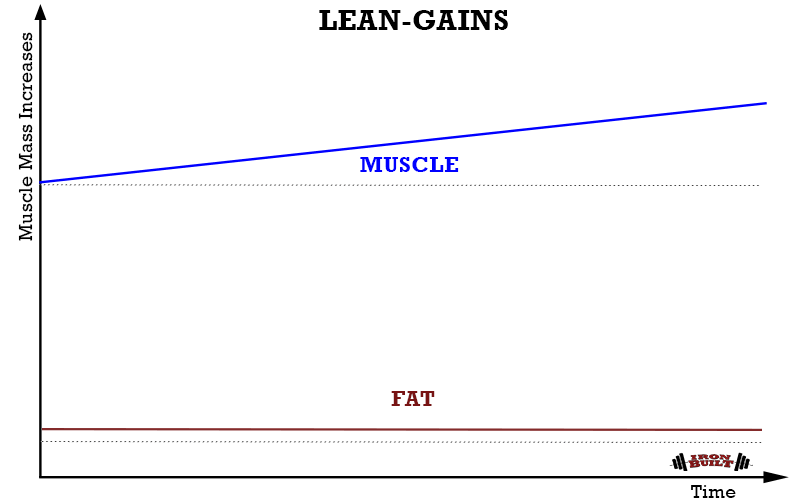
As you can see, you’re gaining very little to no fat, but your muscle building potential is reduced a bit as well.
Should you lean-gain?
The ones I recommend this method for are individuals with a lot of training experience, who have multiple years of training under their belt.
Like WNBF Pro Natural Bodybuilder Jeff Nippard for example:

These individuals are close to their genetic potential when it comes to muscle growth.
So, they need only a very small caloric surplus seen over multiple months, even years to build any new muscle tissue.
I would also recommend this method for individuals that really don’t want to add any fat to their frame, such as actors or professional models that must be in shape year-round for movie roles or photo shoots etc.
Or if you simply just want to stay lean.
How to implement lean-gains:
If you only have a few years of training experience, then you still have the potential to add a fair bit of muscle every month.
Then I’d do the following:
Eat at energy balance (TDEE) the days you’re not training.
Eat ~200 calories above TDEE the days you’re training.
If you follow this setup it’s very likely you’ll put on muscle with minimal fat storage.
If you, on the other hand, are an advanced trainee closer to your genetic potential, then there’s no reason to eat with the same constant caloric surplus to build muscle.
Can you, according to the table above, only build 0.5 lbs (0.22 kg) of muscle per month or ~5 lbs (2.5 kg) per year, you only need a surplus of measly 34 calories per day.
That’s equal to half an apple above maintenance per day!
Eating at your TDEE daily and perhaps indulging in something extra every now and then seems a lot more reasonable for an advanced individual.
3. Lean-Bulk/Controlled Bulk
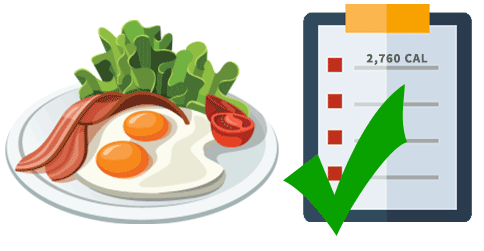
By doing a lean-bulk, you’ll maximize muscle growth while allowing for only a moderate amount of fat to be stored.
If you really want to build muscle as a beginner to intermediate trainee (0-4 years), don’t be afraid of gaining some fat.
It’s really not that bad in the grand scheme of things.
I think that JC Dean’s article the perfect caloric surplus, explained this perfectly.
When you allow for some fat storage, you’ll have a high enough caloric surplus for the hormonal environment in your body to be in favor of muscle growth.
But at the same time, you’re not gaining too quickly, avoiding unnecessary fat gain.
The caloric surplus I recommend is one that allow you to gain at a 1-1 ratio, or slightly below, of muscle and fat.
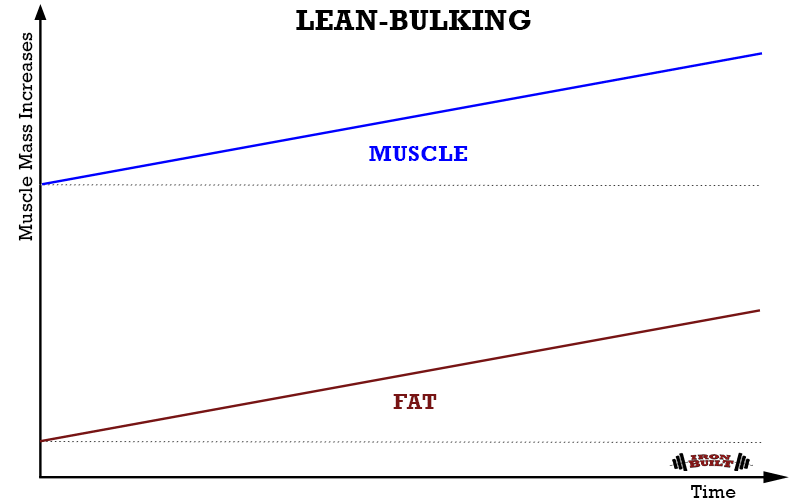
As you can see, when you’re gaining fat and muscle in a 1 to 1 ratio you’re maximizing your muscle building potential while only putting on a moderate amount of body fat in the process.
So, if you’re a beginner and can gain 2 lbs (1 kg) of muscle per month, your total bodyweight should go up 4 lbs (2 kg) per month.
To save you the math, that would mean a caloric surplus of 440 calories per day.
Just to make it more applicable, a surplus of 500 calories per day is a good place to start if you’re a complete beginner who can gain ~2 lbs of muscle per month.
Should you lean-bulk?
I recommend lean-bulk for 80-90 % of beginner to intermediate trainees.
If you’ve been training productively for 0-4 years and are looking to add muscle mass as quickly as possible, without gaining too much fat, this is the method to use.
How to implement a lean-bulk:
Remember Jake?
His goal is to build muscle, and here’s how he would set up his surplus to successfully lean-bulk:
His height is average, he’s an intermediate when it comes to training (2 years of lifting) which means he can build around 1.5 lbs (0.7 kg) of muscle per month.
This means he will focus on gaining 3 lbs (1.4 kg) of total body weight per month to maximize his muscle building potential.
To calculate how many calories Jake must eat per day to achieve this goal, he’ll use the following equation:
- Daily caloric intake = TDEE + (muscle growth per month in kg’s x 125 calories). (125 calories is what Jake needs per day to gain 1.5 pound of muscle per month, based on the ~2500 calories rule to build 1 lbs of muscle) = 3157 calories per day
- To maximize his muscle building potential he should double his surplus number: 3157 + 125 = 3282 calories per day.
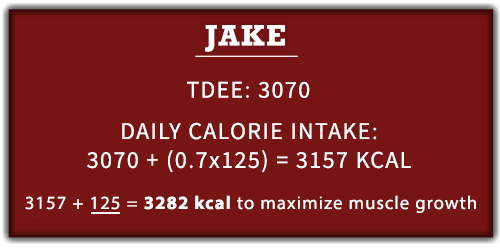
How to Adjust Your Caloric Intake in Case Your Weight Doesn’t Change as Planned
When Cutting
- If you lose weight too fast you risk losing muscle mass and experience other unpleasantries.
- If your weight doesn’t go down fast enough, cut down on the caloric intake.
- Adjust with 200-300 calories per day and wait 1-2 weeks to notice changes.
When Lean-Bulking
- If your weight doesn’t go up fast enough, increase the caloric intake.
- If you gain weight too fast, then you’ve put on too much fat and should lower the caloric intake.
- Adjust with 100-200 calories per day and wait 1-2 weeks to notice changes.
Remember to take water weight into consideration.
You do this by taking daily weigh-ins and measurements over 3-4 weeks before you adjust the caloric intake.
Okay, so that’s it regarding calories – the most important factor for building a lean and muscular physique.
It’s also the factor that lays the foundation for everything we’ll cover next in this guide.
And on that note, let’s move on and look at macronutrients, which in conjunction with a well set up caloric intake decides whether it’s fat or muscle you’ll lose during a cut, or if its muscle or fat you’ll gain during a bulk.
Part 2: How to Set Up Your Macronutrients
At second place in the pyramid we have macronutrients, or macros as they’re typically spoken as.
I’m sure you’ve heard about these nutrient before, they are:
- Protein
- Fat
- Carbs
In this part you’ll learn how to set up these three nutrients to most effectively improve your body composition, whether your goal is cutting, bulking or maintaining.
Furthermore, alcohol also counts as a macronutrient.
Hopefully though, it’s not a nutrient you must depend on to survive.
But, with that said, alcohol still plays a role in our culture today, so we’ll cover alcohol and how you can include it in your diet as well.
Let’s go!
What are Macronutrients?
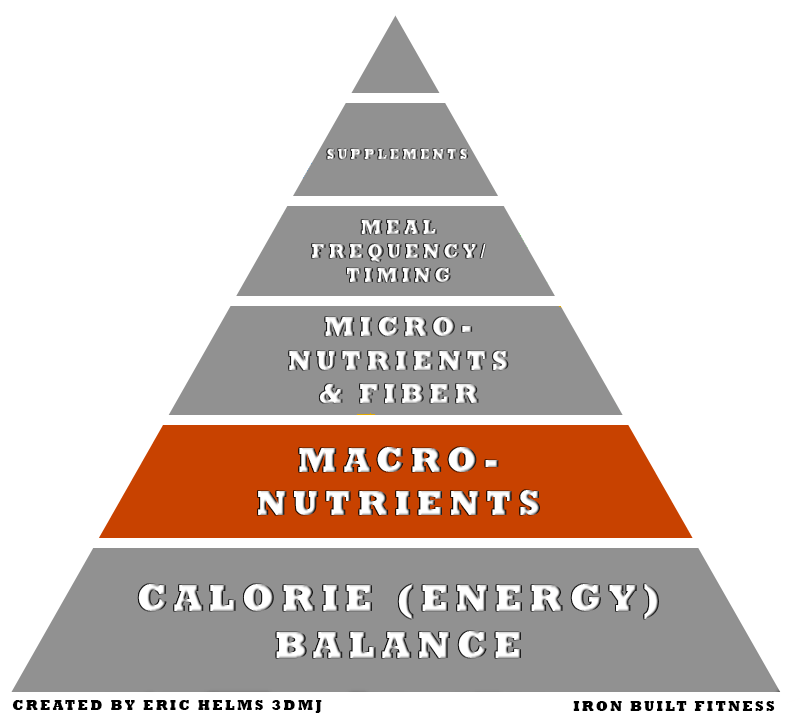
Macronutrients are different compounds that contains our calories, which essentially means they’re the ones providing us with the energy covered in part 1.
Not only that, they also contains building blocks that’s used by the body to recover and repair all it’s cells.
And finally, the macronutrients also make sure that your body is functioning properly. Such as promoting a healthy from hormonal production etc.
What you’re probably the most interested in is how these nutrients can be set up, for you to achieve the body composition you want, i.e. more muscle and less fat.
A good distinction between calories and macros is that calories decide if you gain or lose weight, while macros play an important role in deciding what the weight loss or gain will be composed of.
Let’s discover what each of the macronutrients does and how you can set them up to improve your body composition:
Protein
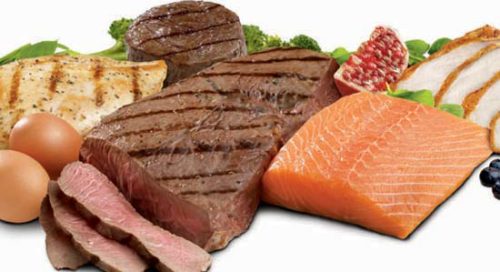
Protein contains 4 calories per gram.
Why Is Protein Important?
Look:
Protein is the building blocks for all the cells in the body.
So when it comes to improving body composition it makes a lot of sense to have a high intake of protein in order to repair and make your muscles grow.
In fact, overall when it comes to creating a better body composition with more muscle and less fat, protein is the number one, most important macronutrient to set up correctly.
Why?
Because, muscle is essentially proteins that your body has stored in a response to earth’s gravity and your movements against that force.
In other words, muscles are built out of protein as a defense mechanism against the movements you make, to ensure that you can handle the movements better in the future.
So, everytime you train hard, you exert a lot of force against the earth’s gravity, and by doing so, your muscles work hard.
When your muscles work hard, they literally break down. (This is what you want, and why you get sore after working out.)
Now, for the body to be able to repair this breakdown and to make you bigger and stronger, it needs something to build with.
And this is where your protein intake comes into the picture.
In fact:
Just imagine for a second that you’re having a low protein intake…
…then perhaps you’re not providing enough building blocks for your body to use as materials to repair the breakdown from training.
What could happen is that you end up spinning your wheels in the gym, or during some circumstances end up losing muscle mass instead.
Furthermore, protein is also the nutrient with the biggest positive effect on satiety compared to carbs and fats, and this can help when cutting.
How Much Protein Should You Eat?
To make sure you’re eating enough protein to improve body composition, here’s the recommendations:

Why Is There a Difference Between Cutting and Bulking?
- Protein helps with preserving muscle mass during a caloric deficit, so the requirement is higher during a cut.
- Protein also help improve satiation during a cut, which also makes a higher intake smart.
- A higher protein intake than 1.8 g/kg of body weight during a bulk won’t give you any additional benefits, your muscle protein synthesis will already be maxed out.
Why Is it a Range in Recommended Intake?
The optimal intake of protein is decided depending on three factors:
- Fat free mass (FFM)
- Body fat percentage
- If you’re cutting, size of the caloric deficit.
Note: Most people should just make sure to end up somewhere in the ranges above, as this is enough to see great results. However, if you’re looking to compete in physique/bodybuilding and need to get down to essential levels of body fat. Then being more accurate with your protein intake gets a lot more important, especially when you’re cutting and starting to get shredded at the same time.
Let’s look at these three factors and why your protein intake should be different:
Fat Free Mass (FFM)
The higher your FFM is the more protein you’ll need to eat. This makes a lot of sense, the higher FFM you have, the more muscle mass you must support, hence more protein required.
So, if you’re a very advanced trainee, close to your genetic potential, aiming for a bit higher protein intake is a good idea.
Body Fat Percentage
The lower body fat percentage you have, the more your body “senses” starvation.
And carrying muscle mass is something the body necessarily don’t want to do.
Why?
Because it’s very energy demanding.
So, if you have a low body fat percentage, or it’s getting lower during a cut, you’ll need more dietary protein, of course in combination with smart training, to retain as much muscle as possible.
Size of The Caloric Deficit
Same as with body fat percentage, if you have a large caloric deficit, your body “senses” starvation and want to get rid of (what the body thinks is) unnecessary muscle mass.
And having a larger protein intake will help you retain muscle when in a large caloric deficit.
With that said though, and as I covered in the previous part:
If you want to make sure that you’re not losing muscle mass and/or experience other unpleasentries, then setting up your caloric deficit accordingly to your body fat percentage is the way to go.
It’s clear that a higher protein intake generally is great for fat loss, but only up to a degree.
There comes a point where protein starts to “steal” to much calories from other sources, mainly carbs, so that your training performance goes down.
And training performance is the number one key for retaining muscle mass on a diet, even more so than protein. (More on that later)
Finally, when it comes to fat loss for general population, i.e. people who’re not looking to get stage shredded like this:

But lean and beach ready, like this:

Then a TON of research on protein intake shows that a intake higher than 0.82g/lb (1.8g/kg) of protein per day for natural trainees is unnecessary.
In fact, a lower protein intake for fat loss comes with a bunch of advantages, because it allows for a higher intake of the other macronutrients.
Okay, so let’s set up our new friends Jake and Julie’s initial protein intakes:
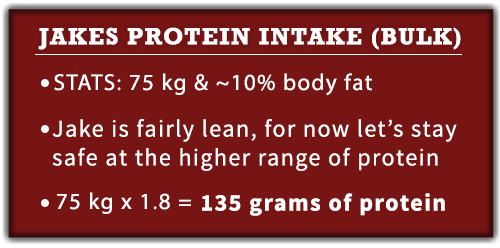
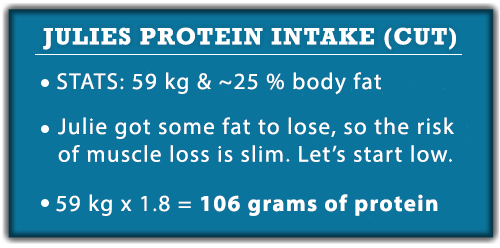
Final notes for setting up protein:
- Overweight individuals can use a larger caloric deficit. However, a larger deficit means more hunger, and because protein is the most satiating macronutrient of them all, it’s wise to keep the intake a bit higher in this case as well.
- Beginners seem to require less protein because their nutrient partitioning is better, following a new stimulus to training.
Protein Powder or Real Food?
Protein powder is a useable tool that can make it easier, and above all cheaper, to reach your daily protein intake.
However, it will always be more satiating to get your protein from “real food.”
Meaning through meat, fish, egg, mycoprotein, soy and dairy products, especially during a cut when hunger is the enemy.
On the other hand, during a bulk, some people find it tough to eat enough calories, where they feel uncomfortably full and puffed. If that’s the case, drinking some of your calories can be a good idea.
Fat
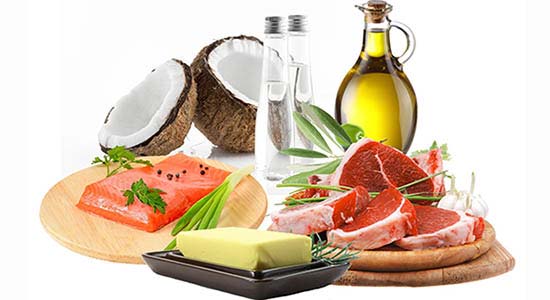
Fat contains 9 calories per gram.
Why Fat is Important
Fat is, just as protein, essential to our survival.
And these are the main tasks of fat in our body:
- Provide us with energy
- Help produce various hormones (testosterone included)
- Help absorb the vitamins a,d,e and k.
How Much Fat Should You Eat?

Fat Intake While Cutting
During a cut, you need to take in fewer calories to start losing body fat.
Because fat is the most energy dense of the macros, you can easily adjust your caloric intake by adjusting your fat intake.
Fat Intake While Bulking
During a bulk, you need to take in more calories to start gaining weight and muscle.
Because fat is the most energy dense nutrient, not only will a higher fat intake be a smoother way to increase your calorie intake, it also gives you the opportunity to eat a wider and more varied diet.
Why is it a recommended range?
First of all, because people that carry more body fat typically do better on a higher fat and lower carb intake.
This has to do with insulin sensitivity (how well you handle carbs), which increases as you get leaner.
So, if you have a high body fat percentage, use the higher number in the range and contrarily if you’re leaner.
And second, to give room for personal preferences.
Here’s the thing:
People are different, which means that some work better on a low-carb high fat diet, while others work better on the opposite. (This probably has to do with insulin sensitivity as well.)
Personally, I’m not much for high fat, low carb diets, because I think they’re too restrictive (I have a harder time adhering to such a diet).
I also experience that my training performance goes down a bit if I turn down carbs too much.
On the other hand though, I’m not much for extremely low fat diets either. If I’m eating low fat I’m not going to feel satisfied after my meals.
So, my initial recommendation is to not go above a maximum of 35 % of calories from fat when bulking, even though there are some individuals that might benefit from higher.
And on the flip side, I don’t recommend that you go much below 25 % either. You could, but doing so typically removes how enjoyable and satiating the diet is perceived.
Furthermore, going much lower than so, like down to 15 % of calories from fat, could potentially be dangerous for someone with a low caloric intake. For hormonal reasons mostly.
Carbohydrates

Carbs contains 4 calories per gram.
Why are Carbohydrates Important?
Carbs, compared to the other two macros, is not a macro you need to eat for survival.
However, carbs have a positive impact on a lot of things when it comes to improving body composition, such as:
- Better hormonal balance in the body.
- Better fueling of anaerobic workouts.
- Refills muscle glycogen (the primarily source of energy used by the muscles.)
- Tastier foods.
I recommend that you only adjust your daily intake between cutting and bulking and not removing carbs completely.
Here’s why:
Resistance training is more important than a high protein intake if you want to preserve muscle during a cut.
And guess what:
Carbs are the main prefered source for the muscles when performing anaerobic workouts such as resistance training.
In fact, around 80 % of high intense exercise uses glycogen as fuel, so having low glycogen stores would affect your workouts negatively.
For that reason, you need to eat enough carbs to have the energy required to perform high intensity workouts to successfully spare your hard-earned muscle mass.
Furthermore, allowing for carbohydrates in your diet makes the food you eat a lot more tasty.
And tastier food makes, contrarily to popular belief, dieting more sustainable long-term. (More on flexible dieting in the next part)
How Much Carbs Should I eat?

Alcohol

Alcohol contains 7 calories per gram.
Why is Alcohol Important?
For many of us, alcohol consumption is a part of life.
Avoiding it completely would be the best thing to do calorie and macro wise. However, that probably won’t be sustainable for most people long-term.
I believe strongly in not completely removing something that you like to indulge in every now and then.
As doing so might lead to problems later instead.
How Much Alcohol Should I Drink?
If you’re anything like most people, here’s what usually happens.
Before heading out they might say to themselves:
“5 units will be enough!”
Later when they’re back home:
“Okay, I had 10, I think?! HiCk.”
Sounds familiar?
This have happened to me a few times…
And it’s bad for body composition, here’s why:
Alcohol includes 7 calories per gram and is often combined with carbs (either from wine, barley/corn/hop in bear or sugar in cider drinks for example).
When alcohol is consumed in moderate amounts, which would be a few units, it’s possible to adjust your caloric intake rather easily.
But when the intake exceeds moderate you’ll have to cut down on the other nutrients more, which usually isn’t sustainable.
The nutrient I would recommend adjusting when drinking would be your carbs.
Just look up the caloric content that you’re going to drink and count these into your daily caloric budget.
By doing this, you’ll make sure the most important part in the nutritional pyramid is covered, which is caloric intake.
Quick Summary of Alcohol
- Alcohol gives you energy but without any of the benefits associated with the other nutrients, and for that reason, too much or to frequent drinking won’t be sustainable.
- Adjust your carbs to make room for alcohol.
- You shouldn’t adjust your protein intake, because it’s what spares your muscle mass.
Conclusion Macronutrients
- Use your daily caloric goal for cutting or bulking.
- Calculate your daily protein intake in grams/lb (or kg) of body weight (0.8-1.3 g/lb of bw for cutting) (0.65-10.8 g/lb of bw for bulking).
- Let 25-35 % of total calories come from fat, both when bulking and cutting.
- Let carbs fill out the remaining calories.
- If you’ll be drinking alcohol on occasion, exchange carbs for alcohol.
Lastly, let’s look at Jake’s and Julie’s final macronutrient calculations:
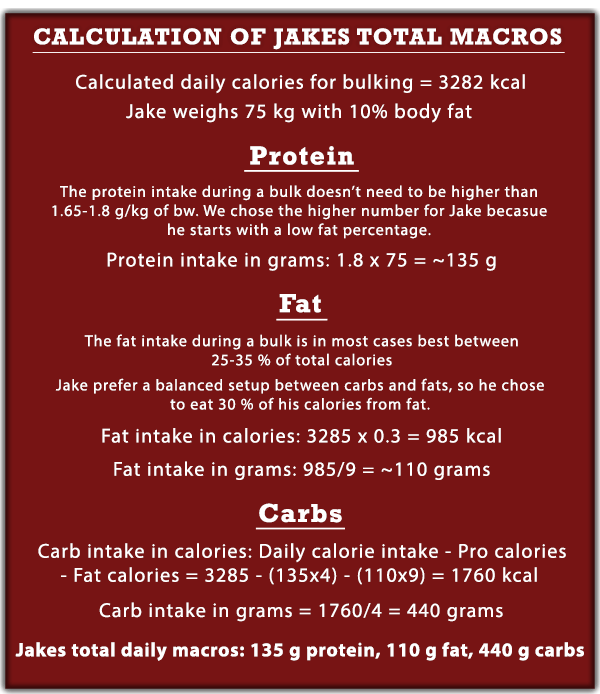
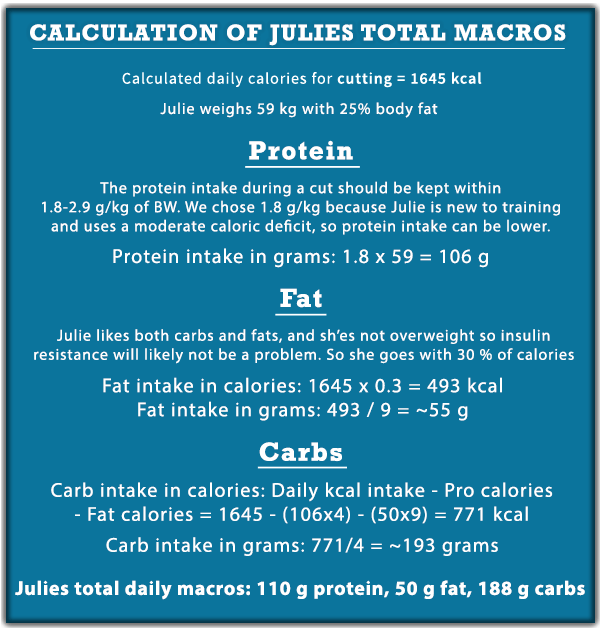
Part 3: Micronutrient and Fiber Intake
In level three of the pyramid we got micronutrients and fiber.
What can be mentioned is that purely for appearances, the two earliest levels, being calories and macros, stands for about 80 % of the results (for reasons already mentioned in respective parts)

However, if you care only for calories and macros, totally neglecting micronutrients and fiber.
Then long-term problems will most likely arise, not only making it harder for you sticking to your diet, but also diminishing your health, and eventually your physique as well.
Fortunately, avoiding these problems is easy, all you need is to follow the simple vegetable intake guidelines we’ll look at in this part.
What are Micronutrients?
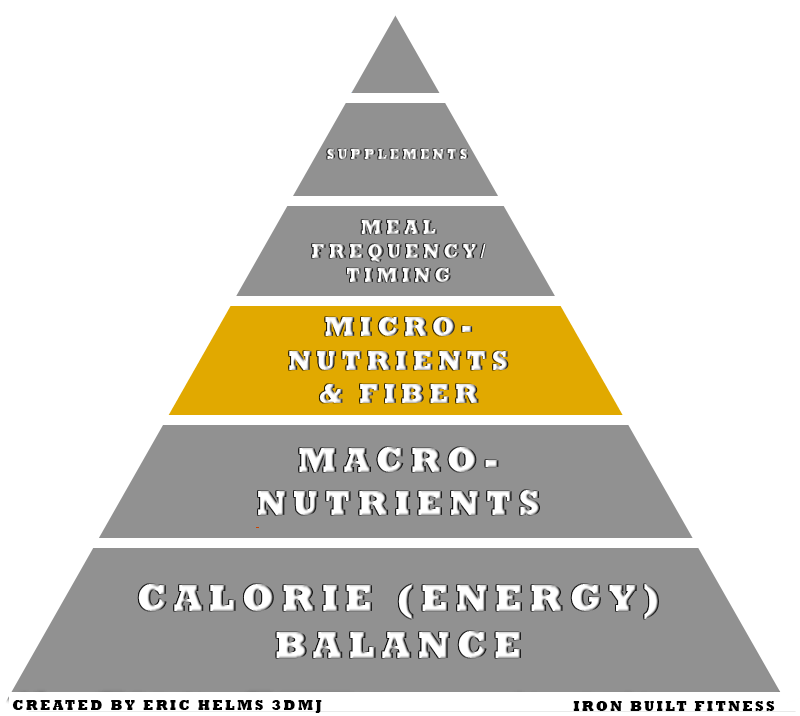
Micronutrients are our vitamins and minerals.
Why they’re named macronutrients, and micronutrients, is because macros (proteins, fats and carbs) you require in large quantities, micros on the other hand you only require in small quantities to orchestrate a range of physiological functions.
Below you can see the most important vitamins and minerals you need in different amounts to support optimal body function and health.
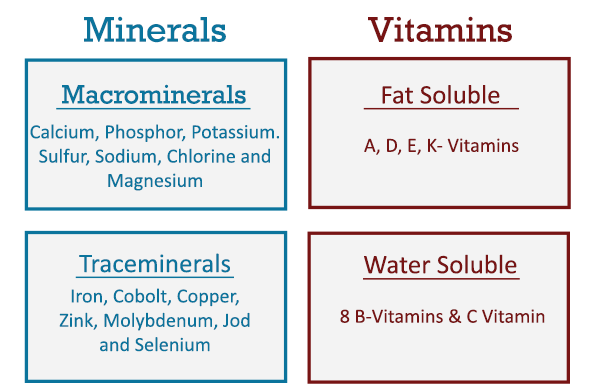
I won’t bore you by going through the functions of every substance, if you are interested in that, just do a simple search on the internet and you’ll have all the information about that single substance there.
Matt Daley over at Brawn for Brains created an awesome essential guide to vitamins and minerals that you can check out if you want to learn more as well.
What I’ll go through is what the differences between the groups are.
- Macro minerals: These are the minerals that help regulate the water balance in your body. They also have the task of making sure that the body’s nervous system works optimally and in balance.
- Trace minerals: These minerals have the task to take care of the transport of different vitamins in the body and many of these minerals are needed to support a good hormonal function in the body as well.
- Water soluble vitamins: These are your 8 vitamin B’s and vitamin C. These vitamins require water to be absorbed by the body. For that reason, it’s difficult to overdose these vitamins because any excess will go out with urine. However, it’s also easier to develop a deficiency for the same reason.
- Fat soluble vitamins: Vitamins A, D, E and K. These vitamins all have different functions in the body, but the most important thing to know is that they require fat instead of water for the body to be able to make use of them. For that reason, it’s easier to overdose these vitamins, because it takes a longer time for the body to get rid of fat than what it does water, which is also why it’s very uncommon to have any deficiencies with these.
As you might realize, getting in enough of these nutrients are important if you want to stay healthy.
What are Fiber?

Fiber helps you feel fuller without increasing calorie intake, it lowers blood sugar levels, delays food digestion, lowers cholesterol, helps you avoid constipation and lowers the risk for colon cancer.
All good reason to include a reasonable amount of fiber in your diet, don’t you agree?
However, it’s possible to eat too much fiber with side effects like gassy stomach, diarrhea, constipation and feelings of puffiness. So, stay within a balanced range and you’ll reap all the benefits of fiber.
Recommended fiber intake:
- Minimum of 20 g/day for women and 25 g/day for men.
- Maximum 20% of your carbohydrate intake.
Fruit and Vegetables Intake Guidelines

Make the following list into a habit and you won’t have to worry about losing out on important micronutrients or fiber.
- Eat one or two fruits every day.
- Eat vegetables rich in fiber with every meal.
- Try to eat a varied diet of different fruits and vegetables.
- If you’re cutting, consider getting a high quality multivitamin supplement.
Other Important Notes Regarding Micronutrients and Fiber
Multivitamin isn’t a substitute for fruit and vegetable intake
Unfortunately, supplementing with multivitamins will make you miss out on different biologically active and beneficial compounds that can be obtained through a proper and varied diet.
It’s important to not only think of micronutrients as essential vitamins and minerals, but to also think of them as containing important phytonutrients and antioxidants. These are compounds that doesn’t classify as neither vitamins or minerals but have the power to optimize health and counteract different diseases.
People that are cutting are at a higher risk of micronutrient deficiency
A meta-analysis made on this subject by Jayson B Calton shows that people that are cutting (being in a calorie deficit) risk having deficiencies in different micronutrients, even though they take care of their diet rather well. So, making sure the fruit and vegetable intake is on point is very important when cutting. This is also when a multivitamin can be beneficial to supplement the diet appropriately.
There seems to be performance benefits of eating vegetables
Vegetables that are green and red in color, such as spinach, arugula, and especially red beets contain a lot of nitrate. A higher intake of nitrate can make your training easier by increasing your tolerance to training. Meaning you can do more volume which equals more muscle in the long run.
Water Intake Guidelines

Staying hydrated is very important for fat loss and performance. To make sure you’re hydrated, follow this list:
- Aim for 5 clear urinations per day.
- Aim to urinate clearly at night.
- Make sure that you’re not dehydrated during your workouts, it will affect your training negatively.
I don’t like to put a recommended water intake for people based on body weight. Some people simply sweat more than others and not to mention how different climates and activity levels can drastically change how much water you require.
Mind-set: Flexible Dieting (IIFYM)
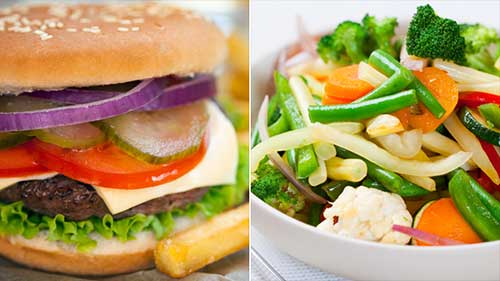
Now you’ve come to what, at least I think, is the most interesting part when it comes to dieting.
Which is:
How much of the tasty stuff can you really indulge in?
And what are the potential benefits and drawbacks of actually allowing yourself to eat some high rewarding stuff sometimes?
Well, before looking at these questions, let me first explain what flexible dieting really is:
Now, flexible dieting is just as it sounds, you are being flexible with your diet.
And being flexible with your diet is extremely important if you want to improve your body composition, while also enjoying yourself as much as possible in the process.
Why?
Because you can eat from all food choices, meaning no restrictions and no saying “no” to foods that you actually like!
And this equals a much less stressful and more enjoyable diet.
Now, flexible dieting is more a mindset than what it is a strategy.
And the way that best describes flexible dieting are, to quote;
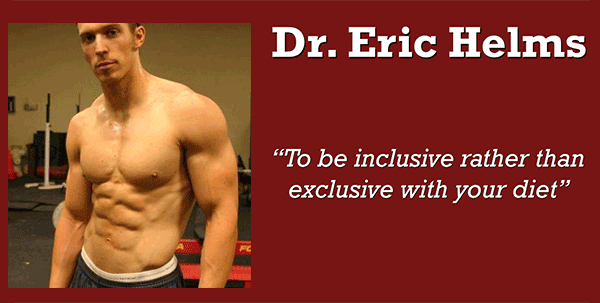
Why Being Inclusive Rather Than Exclusive With Your Diet is a Great Choice
An exclusive diet is where you, for example would strictly eat only chicken, rice and broccoli, day in and day out, except maybe for the occasional cheat meal(s) here and there.
And this is a very common way to diet in fitness circles.
In fact, when someone for example asks me:
“How do I set up my diet for fat loss?”
Eating completely strict with the occasional cheat meal is typically the answer they expect.
But what they don’t realize is that having an exclusive mindset is often negative in the long-run…
Especially if you’re goal is to build a lean and muscular physique and let it be a part of your lifestyle.
Why?
Simply, because it’s restrictive and not enjoyable, which also makes it non-sustainable.
On the other hand though.
By having an inclusive mindset towards your diet, you can remove tons of stress, and also enjoy life as much as possible while you improve your body composition at the same time.
With an inclusive mindset, you’re making yourself the one in control over your diet and not the other way around.
For example:
- Want to eat from the cake at your mother’s birthday party? Then no worries just include it.
- Want to go see a movie with your friends and have a bit of junk food? Again, no worries just include it.
With this said though, you can’t overindulge on junk foods.
And this is a very common mistake.
Your Diet Must Remain Healthy
In order to successfully build a lean and muscular physique, while keeping your health and sanity, you must make sure your diet is also healthy.
A lot of people see the concept of flexible dieting as being a freeway to eat tons of junk food.
But unfortunately, eating to much junk, such as; ice cream, chocolate, candy, chips and so on won’t be sustainable in the long-run either.
I think this neat infographic created by Carter Good, explains perfectly what flexible dieting really is:
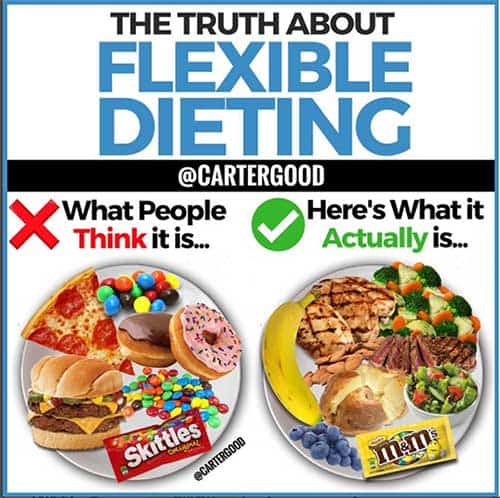
Even though calories and macros mainly are what determines fat loss and muscle growth in the short-term.
In the long-term, you need a diet that contains a full spectrum of micronutrients, such as vitamins, minerals and fiber as well.
If you don’t get these nutrients, your health, performance and eventually your physique will suffer from malnutrition, and this is especially true if you’re in a caloric deficit, trying to lose fat.
So, how do you avoid this while still getting the most out of your diet?
Well, first of all, you abide to the vegetable guidelines above.
And also, you follow something called:
The 80/20 Rule of Dieting
This is where 80 % of your diet contain wholesome nutrient dense foods, and the remaining 20 % can be from lower quality foods.
Here’s a pyramid to keep in mind:

If you follow these guidelines in this pyramid, you will achieve a lot of dieting freedom, be able to improve body composition, and feel great at the same time!
How To Set Up Flexible Dieting
The way to be successful with flexible dieting is to plan ahead when counting your calories and macros.
For example; if you know that by the evening, you are going to an event where they will serve junk food.
Then make sure you eat mostly protein, veggies and other low calorie, highly nutritious foods earlier in the day.
This is to ensure that you’re getting in enough protein, micronutrients and fiber throughout the day, while at the same time keeping calories low.
By doing this, you just created tons of leeway in your diet for the evening, which enables you to eat some of the junk food as well.
Just make sure that you stick within your calorie and macronutrient budget, and you’ll be fine.
The Psychological Benefit of Flexible Dieting
If you’re not currently having an inclusive and flexible mindset when it comes to the diet. Then what certainly will happen if you choose to start implementing one is that your whole view of food will start to shift into a healthier one.
It’s been shown that human beings often want what they can’t have.
In fact, telling yourself that you actually can and are allowed to eat the things you want, but instead you chose to postpone them for later has been shown to be a lot more effective in the long-run, than what being completely restrictive are.
Part 4: Meal Frequency and Nutrient Timing
Meal frequency is basically how frequently you chose to eat during the day.
Do you eat 3 meals per day or 6 meals per day?
Nutrient timing refers to the timing of nutrients, specifically protein and carbs around training.
For example, you might have heard of the controversial anabolic window at some point?
Now, before we get started with this part, here’s something to keep in mind:
We humans have, for as long as it’s known, tried to find shortcuts instead of straining ourselves a bit extra to reach a desired goal.
This is something that salespeople and marketers know and take advantage of.
And when it comes to dieting, this is usually by praising meal frequency and/or nutrient timing to the skies.
Here’s a tip:
When you consume information, be aware if someone tries to turn the pyramid around by making supplements, meal frequency and nutrient timing seem like the most important parts of the puzzle.
They’re probably on a mission trying to earn a few bucks on your uncertainty at this point.
So, just as a friendly reminder, stay away if you realize someone doing this:

Okay, so with that out of the way, let’s look at the truth behind meal frequency and nutrient timing:
Meal Frequency & Nutrient Timing – What Does Science Say?
Let’s start by looking if there are any science supporting whether meal frequency and nutrient timing have any potential physiological benefits.
Nutrient timing
When it comes to nutrient timing for improving body composition, the buzz is all around pre, peri and post workout nutrition.
Let’s start with a meta-analysis done by Alan Aragon and Brad Schoenfeld that looked if there is a post-exercise anabolic window.
Note: A meta-analysis is a gathering of all or many available studies and data on a specific topic, that’s reviewed and assembled into a final conclusion, meaning it’s a highly reliable source of information.
They found that having high quality protein available (20-40 g depending on body size) within two hours post-workout will maximize the anabolic response.
However, how much difference it will make on overall muscular growth is very slim.
Why?
Because the findings didn’t quite reach statistical significance.
Further, they found that you don’t necessarily have to drink that protein shake directly post-workout (as often advertised).
If you ate a large meal including a lot of protein 2-3 hours pre-workout, you already have protein in these amounts available to maximize muscle protein synthesis post-workout.
They also go on to say that:
“Pre-and post-exercise meals shouldn’t be separated by more than approximately 3-4 hours, if however, protein is delivered within particularly large mixed-meals (which are inherently more anticatabolic), a case can be made for lengthening the interval to 5–6 hours.”
They also looked at the timing of carbs, and even though they lack data to form any concrete recommendations, the assumption can be made that carbohydrate availability before, during and after exercise is of greater importance for endurance as opposed to strength or hypertrophy goals.
Furthermore, the widely claimed notion that you should combine protein and carbs post-workout for optimal gains have been challenged by recent studies.
A study by Koopman et al found that adding carbohydrates in quantities of (0.15, or 0.6 g/kg/hr.) post full body resistance training to amplify the protein intake…
…didn’t increase whole body protein balance during a 6-hour post-exercise recovery period, compared to the protein-only treatment.
Meal frequency
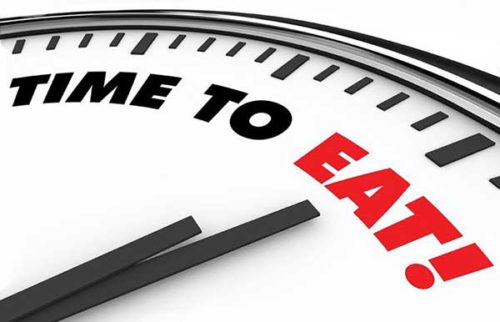
Recently there was another meta-analysis done by Alan Aragon, Brad Schoenfeld and James Krieger that looked at the effect of meal frequency on body composition.
The results:
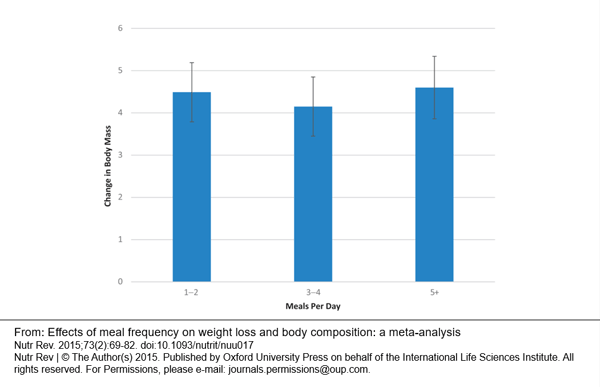
They found no significant difference in body composition changes from eating 1-2 times a day to 5+ times a day. Their conclusion was:
“Given that adherence is of primary concern concerning nutritional prescription, the number of daily meals consumed should come down to personal choice if one’s goal is to improve body composition.”
With that said though, when it comes to nutrient timing for muscle growth, Eric Helms said the following in this great interview with Radu Antoniou:
 “The current research suggests that to maximize protein synthesis it’s best to have three or more protein feedings spread out throughout the day. Just one or two feedings should be inferior although we don’t know by how much. Probably very little.”
“The current research suggests that to maximize protein synthesis it’s best to have three or more protein feedings spread out throughout the day. Just one or two feedings should be inferior although we don’t know by how much. Probably very little.”
There’s a Difference for High Level Athletes
Now, the studies that were reviewed in both of the meta-analyses above was mostly done on obese, non-training individuals.
In the meal frequency meta, of the 15 studies that was pooled only 3 was on lean populations, and 2 on exercising individuals.
For well trained and lean individuals on the other hand, like dieters preparing for a bodybuilding or physique contest, or highly advanced sports athletes, nutrient timing and meal frequency gets increasingly more important.
This is true because the constant signaling of “lose muscle” caused by the body when the fat percentage gets unnaturally low, or when an athlete is at peak performance for a specific sport.
This infographic from an awesome article about nutrient timing over at Precision Nutrition explains perfectly how important nutrient timing (and frequency) really is depending on circumstance:

So, except for the very leanest, muscular, and most peaked athletes, the benefits of nutrient timing and meal frequency is more for long-term psychological adherence to the diet, with only small actual physiological benefits.
In fact, for improving body composition, this is basically how the different levels can be categorized:
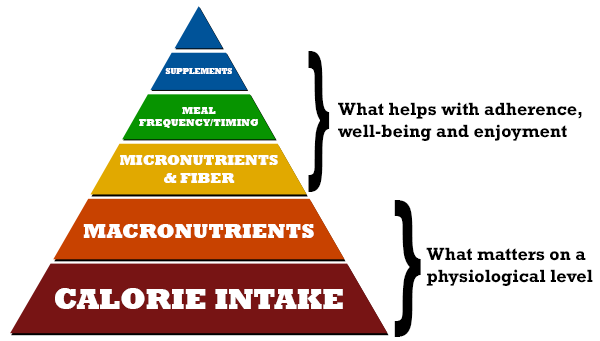
Follow a Meal Frequency and Nutrient Timing that you Enjoy and Can Stick to
This is important.
Since there doesn’t seem to be a lot of physiological benefits or drawbacks of different nutrient timing and meal frequencies, you might as well use it to your psychological advantage.
I do it all the time.
When it comes to meal frequency I believe wholeheartedly in intermittent fasting.
For me, that’s a diet structure which keeps me full, satisfied and happy, especially when I’m cutting.
If you’re interested in reading more about intermittent fasting, check out these articles:
- Intermittent Fasting for Fat Loss – The 5 Awesome Benefits That Will Help You Get Ripped (Effortlessly)
- What’s The Best Intermittent Fasting Schedule For Getting Lean and Ripped?
- Intermittent Fasting for Muscle Growth – Gains Killer or Gains Winner?
- 8 Intermittent Fasting Tricks That’ll Make Your Fast Feel Like a Breeze
Summery Meal Frequency & Nutrient Timing
When it comes to setting up your diet to improve body composition, this is basically what you need to know about meal frequency & nutrient timing:
- Meal frequency and timing is much less important than calories, macronutrients and micronutrients.
- Timing of nutrients (protein) around training do maximize the anabolic response. However, the benefits are small and if food is ingested in medium to large quantities anywhere within 3-5 hours before the workout, muscle protein synthesis will be maximized anyways.
- For the average person, there seems to be no significant difference on body composition between different meal frequencies. It might be for more lean and muscular individuals.
- Follow a meal frequency and nutrient timing that you enjoy and can stick to.
Part 5: Supplements Worth Taking
Supplements are a very interesting subject.
It’s fascinating that something with such low overall importance when it comes to improving body composition is so highly glorified…
In fact, one of the first and most common questions I get by beginners is:
“What supplement should I take?”
This shows just how easy we fall for different types of marketing and advertising.
With that said, there are some supplements that might be worth considering during the right circumstances.
And that’s what we’ll be looking at in this part.
Just remember though, supplements mean very little in the grand scheme of things, and that’s why they’re placed at the top of the pyramid when it comes to improving body composition.
The Truth About Supplements
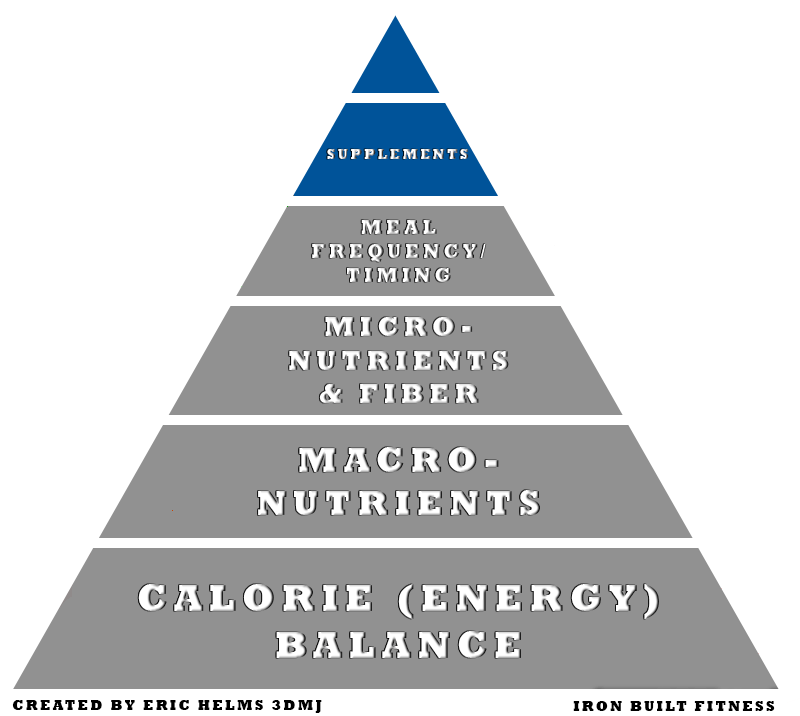
Most supplements are unnecessary…
Why?
Well, because they don’t do that much to improve your body composition.
Some of them are just powdered calories and macros, such as gainers, protein and carb/glucose supplements, others just cost a lot of money without providing any value at all, such as BCAAs.
Sure, maybe some supplements such as creatine and the right kind of pre-workouts can make a tiny 3-5 % difference at most.
But… now you’re probably thinking:
“Isn’t a 3-5 % difference something worth considering?”
And yes it is.
But remember this:
In order for supplements to be worth your time and money, then everything else covered in this guide so far has to be optimized before you start questioning which supplements to use.
But, if your diet is set up correctly following the hierarchy in this guide, then there are some supplements worth considering.
Let’s look at them now:
Supplements Worth Taking
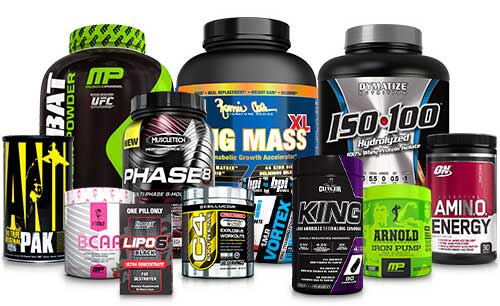
Before you go out and buy the stack in this image, it’s important that the supplements are of high quality.
Unfortunately, the supplement industry is very hard to navigate, because where there’s money there’s manipulation.
For that reason, you need a tried and trusted supplement company that focuses on quality before anything else.
And my recommendation is definitively:
Legion Athletics is a company founded by fitness coach, blogger and author Mike Mathews who also runs the famous site and blog Muscle for Life.
*I’m an affiliate of Legion and I make a small commission if you choose to purchase something from Legion Athletics at no extra cost to you. With that said, I would never recommend something that I don’t use myself. And I’ve personally used and benefited from Legion’s products for over 5 years now.
Okay, so let’s look at the supplements that might be useful in the right circumstance.
Protein Powder

Using a protein powder, like whey or casein is a cheap and effortless way to increase your daily protein intake.
In fact, when looking at the cost of protein gram for gram, powders are actually cheaper than whole foods, typically.
With that said though, your diet should still be wholesome and nutrient dense in order to support health and optimal performance.
But if you struggle getting in all your protein, then a supplement is worth considering.
Here are a few examples of when hammering down a protein shake can be beneficial:
1. When you’re eating out and the food don’t include enough protein.
This is a time when it’s worth having a shake to reach your protein goal for the day.
Just make sure that you don’t ingest too many calories by having protein shakes to allow for more junk food though.
2. During a bulk.
Some people have a hard time eating enough to maintain a calorie surplus, that’s a perfect time to have a few shakes during the day to add some liquid calories that are easier to digest.
3. If you eat a vegetarian or vegan diet
When eating a vegetarian or vegan diet, the protein that you get from wholesome foods such as; soy, beans and lentils etc. are typically combined with either carbs or fat.
What this does is making it hard to reach higher intakes of protein, without going over your calorie budget, especially if your caloric intake is small.
This would be a perfect place for a high quality protein powder. Such as, Thrive, which is a vegan based protein rich in muscle building amino acids.
You can learn more about Thrive here.
Multi Vitamin
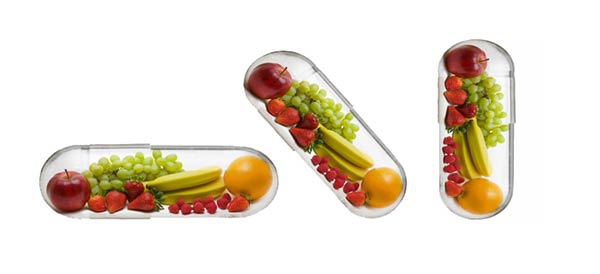
You should try to eat as much of a varied diet as you can, that includes a lot of fruit and vegetables.
If you do so, the risk of losing out on important micronutrients is slim.
However, when you’re in a caloric deficit, trying to lose fat, then you might not get all micronutrients just from food itself, even if you eat a well set up diet.
In fact, the risk of micronutrient deficiencies increases dramatically when cutting.
So, investing in a high quality multivitamin supplement is a good way to avoid getting any deficiencies when cutting.
I recommend Triumph multivitamin from Legion. You can learn more about it here.
Caffeine

Caffeine is an awesome stimulant which has been shown to increase athletic performance in everything from endurance to anaerobic endeavors and heavy lifting.
However, the body builds up a tolerance for caffeine rather easily, and to maintain the positive benefits of caffeine on athletic performance, do one or more of the following:
- Don’t ingest more than 100 grams of caffeine daily (maximum 2 cups of coffee.)
- Cycle your use of caffeine by taking 3-7 days off caffeine every 1-2 months if taken daily. Amount of days off depends on the amount of caffeine you drink.
- Some people experience withdrawal headaches, if you’re one of them, use caffeine only for workouts that you feel you really need it for. Like when sleep deprived or for a heavy leg training session, etc. This way you’ll never build up a tolerance and won’t need to cycle caffeine.
Creatine

Creatine is a molecule produced naturally in the body, it’s also found in some foods like meats and fish. A typical omnivorous diet provides around 1 gram of creatine per day which isn’t quite enough to see the benefits that you’ll see from supplementation.
Creatine has hundreds of studies showing its efficacy and safety as it’s been shown to improve strength and power in athletes again and again.
Examin.com has a complete guide on creatine which digs deeply in on all the science backing up the production of more ATP when energy demands are high, such as during high intensity lifting.
And while creatine does drive water into the muscle through osmosis, it doesn’t cause water retention anywhere else. As such it gives muscles a fuller, tighter appearance and not a bloated watery one.
While it will not increase muscle size on its own, it will increase performance in the gym, resulting in more weight being lifted which results in a larger stimulus for growth. That’s why long-term supplementation of creatine tends to be associated with more muscle growth.
There’s also no need to load creatine or to cycle off it. As unlike caffeine, the body doesn’t develop a tolerance to its effects, and a 2003 study showed that 21 consecutive months of supplementation lead to no ill health effects.
It’s been hypothesized in the literature that so call creatine non-responders exist, with one paper estimating that as much as 30 % of people fall into this category. These people supposedly don’t get any benefits of creatine at all.
But, since creatine is so easily available and very cheap, I think it’s worth to do some self-experimentation to see if it works for you.
A good way to see if it works is if you’ve gained weight while starting to use creatine for a couple of weeks, giving of course that your diet and training variables are being controlled.
For Creatine I recommend the post-workout called Recharge. You can learn more about it here.
Supplement to Take for Fun!
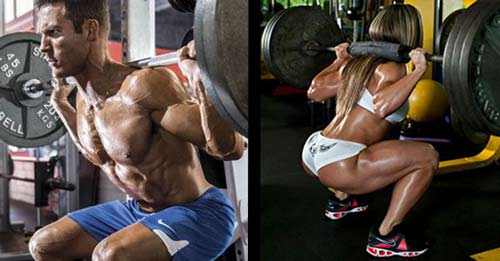
The coming supplement is one that’s typically found inside different PWO’s often in combination with caffeine.
Why I’ve decided to put it in the category of “supplement to take for fun” is that it only has some scientific support for benefitting gains in muscle and strength directly on a physiological level.
However, the supplement can be fun which might lead to indirect positive results on strength and muscle growth by using it.
And the supplement is:
Citrulline Malate
This is an amino acid that increases nitric oxide concentration in the blood by converting to arginine in the kidneys. Arginine then tells the smooth muscle in arteries and veins to relax, causing pump and vascularity.
Because Citrulline Malate is better absorbed in the gut than what arginine is directly, it’s a safer way to get these benefits without also getting diarrhea. And on a further note, counterintuitively supplementing with Citrulline Malate leads to higher arginine levels than taking pure arginine.
Now, Citrulline Malate isn’t just merely a pump product, it has some science showing that it can increase athletic performance and relive muscle soreness.
In this study, subjects where instructed to perform as many reps as possible on the bench press for 8 sets. Found was that Citrulline Malate yielded more reps per set for all sets after set 2.
Also, the impact of supplementation seems to increase the more sets that was performed.
This means that for higher volume training, there’s a high chance that Citrulline malate can help you crank out a few extra reps. As a matter of fact, 100% of 41 subjects in the study responded positively on set 8.
The same study also showed a significant decrease of 40% in muscle soreness at 24 hours, and 48 hours after the training session was completed. The authors attributed this effect to be Citrulline Malate’s ability to buffer acids in metabolites like lactate and ammonia.
Now, this is obviously just one study and more data should be provided before knowing for sure if it’s worth it to supplement with Citrulline Malate. But even without these added benefits, the pump alone can make training more enjoyable by making you look bigger in the gym.
So, I usually recommend taking 4-10 grams of Citrulline Malate, about 1 hour before training.
To get your dose of Citrulline Malate I recommend taking Pulse before your workout. You can learn morea bout it here.
Note: There are speculations that when it comes to muscle growth specifically, the effects of buffering acids in metabolites to increase anaerobic endurance might actually be negative. This is because when increasing the anaerobic endurance while simultaneously having the goal of building muscle, you must do more total volume to achieve the same benefits.
Now, don’t get me wrong, more training volume over time is known as a major signaling for hypertrophy, and “metabolite high rep training” is a very effective method of increasing volume. So, wouldn’t it make sense to supplement with Citrulline Malate?
Well the thing is, when it comes to using metabolite training, the signaling for muscle growth is the fact that the accumulation of metabolites such as lactate and ammonia is getting too high.
In other words, the earlier you can accumulate high levels of metabolites (i.e. without Citrulline Malate) the less total pump training you have to do for the same amount of muscle growth.
Now, the benefits of having a pump with increased arousal and motivation when training, might provide a better stimulus for growth than this potential drawback, that’s not certain yet.
So, if you’re looking to spend money on something, Citrulline Malate might be, or might not be, worth it.
With that said however, getting pumps is certainly fun, so it’s totally up to you!
Now It’s Your Turn
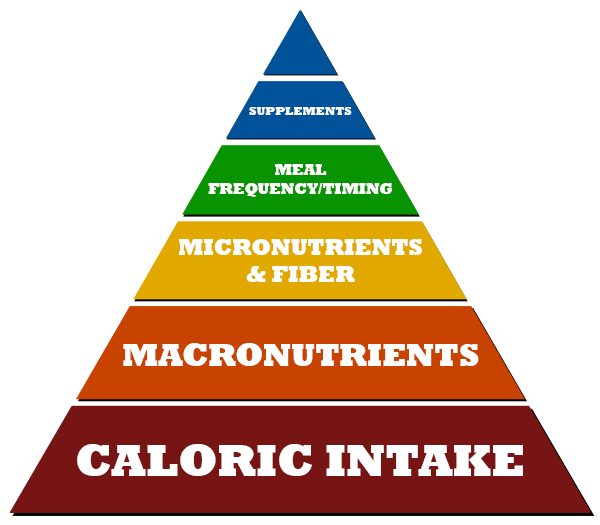
Dieting to improve body composition certainly has a clear order
of importance
Now I want to turn it over to you: Is there a part in the pyramid that you perhaps have put to much focus on?
Or do you already follow this order of importance when dieting?
Let me know by leaving a qick comment below right now.
